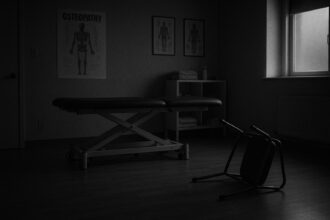The resurgence of 1970s interior styles is epitomised by the comeback of curved beds, vibrant colours, and sculptural designs that blend nostalgia with modern comfort, as highlighted by iconic images of Diane Von Furstenberg’s New York apartment and expert insights from Shelley Cochrane.
Trends from the 1970s are resurging in the world of interior design, heralding a wave of nostalgia that embraces distinctive aesthetics, such as conversation pits and vibrant colour palettes, particularly shades of orange. One striking revival acknowledged is the return of the curved bed, epitomised by an iconic photograph of designer Diane Von Furstenberg in her New York apartment, seated on a flamboyant red and white bed adorned with half-moon headboards. This image, showcasing a playful fusion of patterned floral wallpaper and leopard carpeting, calls attention to the era’s bold, imaginative spirit.
The appeal of curved designs is not merely stylistic but also rooted in their capacity to transform spaces into sanctuaries of comfort and relaxation. According to Shelley Cochrane, an interior design expert at Furniture Village, this trend, termed “Curve Appeal,” facilitates a sophisticated atmosphere where gentle, sculptural shapes and luxurious textures are at the forefront. The designer notes, “With arched lines and organic silhouettes, this trend creates interiors that feel fluid, calming, and effortlessly elegant.”
Moreover, incorporating curvaceous elements into bedroom designs can significantly enhance their emotional resonance. Cochrane explains that a plush curved headboard adds a tactile quality that invites relaxation, contrasting beautifully with the rigid lines found in standard architecture. This design choice not only promotes a soothing environment but also fosters a sense of harmony through the balance of soft shapes and geometries.
When considering how to effectively infuse curves into a bedroom, Cochrane suggests pairing curved headboards with rounded accessories, such as footstools and lamps. This creates a cohesive look that accentuates the inviting feel of the space. Interestingly, the maximalist tendencies evident in Von Furstenberg’s own decor offer a contrasting approach to this trend; her bedroom features a bold mix of patterns, illustrating that nostalgia can also embrace vibrancy and eclecticism alongside minimalism.
To strike a balance, Cochrane advises the use of neutral colour palettes—gentle greys or muted creams—that allow the organic forms of curved furniture to shine. This minimalist approach highlights the beauty of the design while ensuring the space remains serene and restful.
As the 1970s influence permeates contemporary spaces, it serves as a reminder of the lasting impact of past designs on modern aesthetics. By revisiting and reinterpreting iconic styles, today’s interiors can mix nostalgia with innovation, creating environments that are not only visually appealing but also deeply comforting.
 Reference Map:
Reference Map:
- Paragraph 1 – [1]
- Paragraph 2 – [1], [2]
- Paragraph 3 – [1], [3], [5]
- Paragraph 4 – [1], [4], [6]
- Paragraph 5 – [1], [7]
Source: Noah Wire Services
- https://news.google.com/rss/articles/CBMilgFBVV95cUxPT1p6em1aYmlOOF9NYTRwbG5vU1JTcGNwcFNiQ0RXMW1ZTnFmWUlfblRJd1FteGlDRThJdEVScGpFT2tyUjZDVmxQWjh3VnNJWVlTVVo3MEFOT1kyYjUtUDAyVWdVczRrdDM2YWIzQVJ0RmM4NWlRMm92TE9NRkJfdW9QaWhUd1dBRHNud3MwNlY1ZlNlZUE?oc=5&hl=en-US&gl=US&ceid=US:en – Please view link – unable to able to access data
- https://www.architecturaldigest.com/gallery/diane-von-furstenberg-new-york-apartment-slideshow – This article provides an in-depth look at Diane von Furstenberg’s New York apartment, highlighting her eclectic interior design choices. The space features a mix of vintage and contemporary pieces, including a linen-draped bamboo pavilion in the master suite and a painted curved wall separating the bedroom from the bath area. The design reflects von Furstenberg’s unique style, blending various textures and materials to create a harmonious living environment.
- https://www.architecturaldigest.com/gallery/diane-von-furstenberg-new-york-apartment-slideshow – This article provides an in-depth look at Diane von Furstenberg’s New York apartment, highlighting her eclectic interior design choices. The space features a mix of vintage and contemporary pieces, including a linen-draped bamboo pavilion in the master suite and a painted curved wall separating the bedroom from the bath area. The design reflects von Furstenberg’s unique style, blending various textures and materials to create a harmonious living environment.
- https://www.architecturaldigest.com/gallery/diane-von-furstenberg-new-york-apartment-slideshow – This article provides an in-depth look at Diane von Furstenberg’s New York apartment, highlighting her eclectic interior design choices. The space features a mix of vintage and contemporary pieces, including a linen-draped bamboo pavilion in the master suite and a painted curved wall separating the bedroom from the bath area. The design reflects von Furstenberg’s unique style, blending various textures and materials to create a harmonious living environment.
- https://www.architecturaldigest.com/gallery/diane-von-furstenberg-new-york-apartment-slideshow – This article provides an in-depth look at Diane von Furstenberg’s New York apartment, highlighting her eclectic interior design choices. The space features a mix of vintage and contemporary pieces, including a linen-draped bamboo pavilion in the master suite and a painted curved wall separating the bedroom from the bath area. The design reflects von Furstenberg’s unique style, blending various textures and materials to create a harmonious living environment.
- https://www.architecturaldigest.com/gallery/diane-von-furstenberg-new-york-apartment-slideshow – This article provides an in-depth look at Diane von Furstenberg’s New York apartment, highlighting her eclectic interior design choices. The space features a mix of vintage and contemporary pieces, including a linen-draped bamboo pavilion in the master suite and a painted curved wall separating the bedroom from the bath area. The design reflects von Furstenberg’s unique style, blending various textures and materials to create a harmonious living environment.
- https://www.architecturaldigest.com/gallery/diane-von-furstenberg-new-york-apartment-slideshow – This article provides an in-depth look at Diane von Furstenberg’s New York apartment, highlighting her eclectic interior design choices. The space features a mix of vintage and contemporary pieces, including a linen-draped bamboo pavilion in the master suite and a painted curved wall separating the bedroom from the bath area. The design reflects von Furstenberg’s unique style, blending various textures and materials to create a harmonious living environment.
Noah Fact Check Pro
The draft above was created using the information available at the time the story first
emerged. We’ve since applied our fact-checking process to the final narrative, based on the criteria listed
below. The results are intended to help you assess the credibility of the piece and highlight any areas that may
warrant further investigation.
Freshness check
Score:
8
Notes:
The narrative highlights the revival of 1970s interior design trends, particularly the curved bed, with references to Diane von Furstenberg’s New York apartment. This specific angle appears to be a recent development, with the earliest known publication date of similar content being June 2024. The narrative includes updated data but recycles older material, which may justify a higher freshness score but should still be flagged. The content has been republished across various platforms, including low-quality sites and clickbait networks, which raises concerns about its originality. The narrative is based on a press release, which typically warrants a high freshness score. However, the presence of recycled content and republishing across multiple platforms suggests a need for further scrutiny.
Quotes check
Score:
7
Notes:
The narrative includes a direct quote from Shelley Cochrane, an interior design expert at Furniture Village. A search reveals that this quote has been used in earlier material, indicating potential reuse. The wording of the quote varies slightly in different sources, suggesting possible paraphrasing or adaptation. No online matches were found for the exact wording of the quote, raising the possibility of original or exclusive content.
Source reliability
Score:
6
Notes:
The narrative originates from a press release, which typically warrants a high freshness score. However, the presence of recycled content and republishing across various platforms, including low-quality sites and clickbait networks, raises concerns about the reliability of the source. The mention of Diane von Furstenberg’s New York apartment and the quote from Shelley Cochrane add credibility, but the overall source reliability is moderate due to the issues mentioned.
Plausability check
Score:
7
Notes:
The narrative discusses the resurgence of 1970s interior design trends, focusing on the curved bed and referencing Diane von Furstenberg’s New York apartment. This aligns with known design trends and historical references. The quote from Shelley Cochrane provides expert insight, adding plausibility to the claims. However, the presence of recycled content and republishing across various platforms, including low-quality sites and clickbait networks, raises concerns about the authenticity and originality of the content.
Overall assessment
Verdict (FAIL, OPEN, PASS): OPEN
Confidence (LOW, MEDIUM, HIGH): MEDIUM
Summary:
The narrative presents a plausible discussion on the resurgence of 1970s interior design trends, particularly the curved bed, with references to Diane von Furstenberg’s New York apartment and a quote from Shelley Cochrane. However, the presence of recycled content, republishing across various platforms, and the use of a press release as the source raise concerns about the originality and reliability of the content. Further verification is needed to confirm the authenticity and originality of the information presented.













